Menus
- This is how the 2017 model drives
- IMU comes from the ZX-10R
- Initial tires remained the same
- 2017 model even more suitable for touring
- 2017 model – what’s new?
- Technical data Kawasaki Z 1000 SX
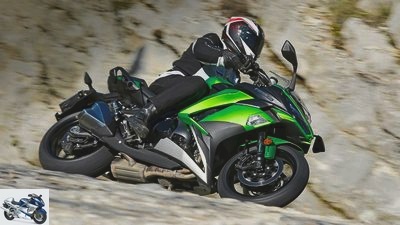
Photo: Kawasaki
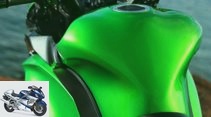
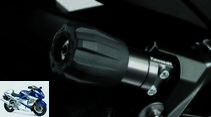
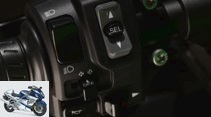
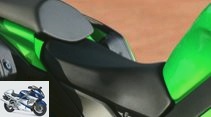
11 photos
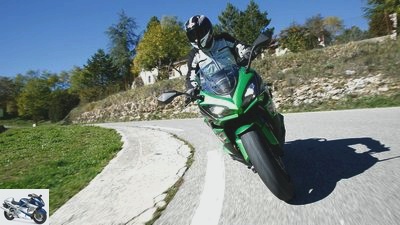
Kawasaki
1/11
The LED headlights are part of the new front fairing. They should shine brighter and wider at the same time.
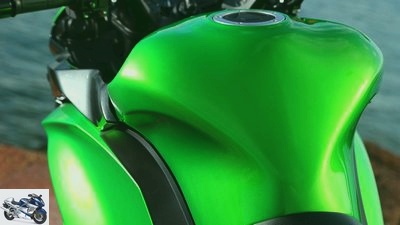
Kawasaki
2/11
An important contribution to the successful ergonomics on the SX is made by the tank with its deeply drawn-in flanks and the narrow rear.

Kawasaki
3/11
A still brilliant middle ground between hook wrench and ESA: The adjustment of the spring preload by handwheel has been adopted for the new SX.
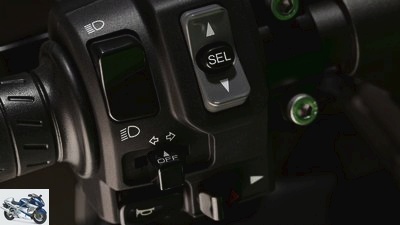
Kawasaki
4/11
The many switches on the left handlebar fitting can be operated almost instinctively. You only have to “learn” the switch for the hazard warning function.
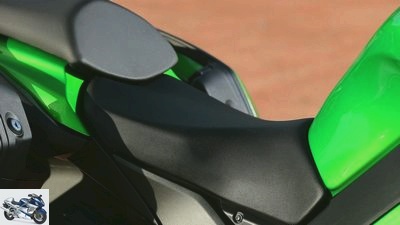
Kawasaki
5/11
The newly designed bench is wider and thicker, but nicely padded. And wonderfully comfortable, even on long tours with thousands of curves.
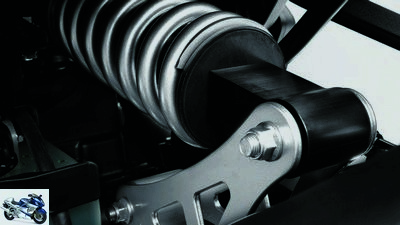
Kawasaki
6/11
The modified lever system provides more comfort. Thanks to a wide setting range, it can also satisfy sporty drivers.
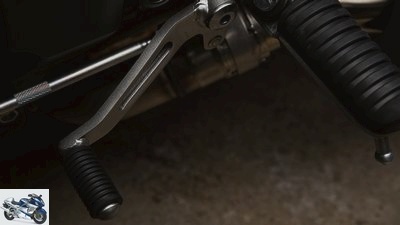
Kawasaki
7/11
The rubberized footrests absorb some of the engine vibrations. The circuit worked differently in two different copies.
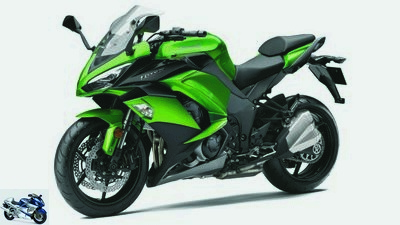
Kawasaki
8/11
If the handlebars were lower, the SX could be mistaken for an athlete. In fact, it has become more suitable for touring.
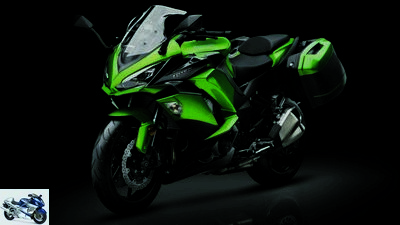
Kawasaki
9/11
… with suitcases.
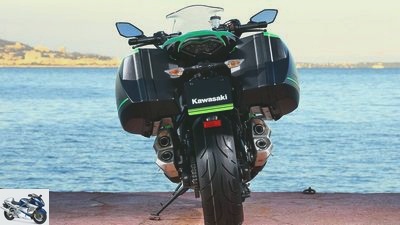
Kawasaki
10/11
Case holders are part of the standard equipment, the cases are integrated into the motorcycle so as to be sucking.
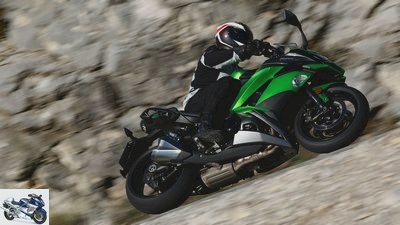
Kawasaki
11/11
Kawasaki Z 1000 SX
Kawasaki Z 1000 SX (2017) in the driving report
This is how the 2017 model drives
Kawasaki brings fresh green into autumn: the revised Kawasaki Z 1000 SX was presented as the first model of the 2017 vintage at the end of October. A first driving impression of the refreshed sports tourer.
“You will do a typical SX tour,” announced Martin Lambert, the press spokesman for Kawasaki Europe. It speaks for the qualities of the Kawasaki Z 1000 SX that it was not an easy tour. Right through the dense holiday home belt on the Cote d’Azur, we went up to the cornering paradise of the Provencal Pre-Alps, at temperatures that were only just above freezing point in the morning. Wet roads on the shady north sides of the mountains, then again sunlit, enjoyable curves, bumpy roads, gourmet asphalt and everything in quick succession – it was a long, demanding and beautiful route. The engine made the first strong impression. It was made fit for Euro 4 above all by two larger catalytic converters that do not affect its characteristics. They have not noticeably harmed the powerful torque of the 1.043 or its performance at high speeds. As before, at the apex of tight turns, the speed can drop below 3,000 rpm; then the four-cylinder pulls a little grumpy, but still vigorously.
Buy complete article
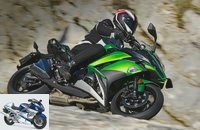
Kawasaki Z 1000 SX in the driving report
This is how the 2017 model drives
Quickly found rhythm on the Kawasaki Z 1000 SX
Most of the time, you stay between 3,500 and 7,000 rpm in winding terrain, preferring to drive in higher gears than at high speeds. With the Kawasaki Z 1000 SX it is easy to get into a brisk rhythm, especially since its engine pleases with its very smooth load changes in this speed range. Naturally, they become a bit more jagged when the stronger engine braking torque comes into play at high speeds, but they remain pleasant overall. On sustained inclines or when the driver lets the engine speed well above 7,000 rpm in high spirits, the tone of the four-cylinder engine and its running behavior change to match the violent acceleration – it vibrates much more strongly than at low and medium engine speeds. It doesn’t really run smoothly in these areas either, so it has remained true to itself in this respect as well. Another example ran quieter, but without showing a fundamentally better smoothness.
IMU comes from the ZX-10R
Significant changes, which are not visible from the outside and are rarely noticeable while driving, have been made in the electronic driving aids. Like the super sporty ZX-10R, the Kawasaki Z 1000 SX also received a so-called inertial measurement unit (IMU) in order to collect data about the riding condition of the motorcycle as precisely as possible. Acceleration in all three axis directions plus roll and yaw rates are recorded and used to control the ABS functions as well as traction and wheelie control. However, SX drivers can only select three different modes of traction control or switch them off. Then the wheelie control is also deactivated. When presented, the traction control was level one, which intervenes the least, and it did not have to intervene.
In any case, the cornering management system is more important for driving, which is so called because both electronics supplier Bosch and Kawasaki themselves avoid the term “cornering ABS” like the devil avoid holy water. In fact, the system prevents the front wheel from locking when braking in an inclined position, provided – and this is the reason for the reluctance to use the term cornering ABS – the driver has not overwhelmed the front tire before braking in an inclined position and the grip conditions remain constant. The system worked very efficiently during a test braking in a roundabout with a large radius. When it intervenes, the driver of the Kawasaki Z 1000 SX feels a slight pulsation of the brake lever, otherwise the reactions of the motorcycle remain unspectacular. One decelerates in an inclined position. Nothing else.
Initial tires remained the same
The first tires of the Kawasaki Z 1000 SX of the Bridgestone S 20 type in the special specification N have remained the same. The tires, however, were new. A test has to clarify how the SX behaves with somewhat worn tires. After almost 500 kilometers in a day and a half, the SX could still be willingly tilted. With a new front fairing, Kawasaki has freshened up the look of the Z 1000 SX, and a newly formed, still three-way adjustable windshield is supposed to improve the wind protection. Whether this has been successful cannot be said without a direct comparison, but the windshield directs the wind in the lowest position to the driver with pleasantly little turbulence and noise.
2017 model even more suitable for touring
As a further asset in terms of comfort, the new Kawasaki Z 1000 SX offers a modified adjustment of the spring elements and a new lever system. It should respond better to bumps with a flatter progression in the beginning. In fact, the suspension of the SX worked quite sensitively, even smoothing bumps in quick succession. Only when accelerating over bumps did the hindquarters occasionally pump. Compared with the loss of comfort on a tighter motorcycle (rebound and compression stages open only one turn at the front and rear) this was the smaller problem. The adjustment ranges of the damping are so wide that any setting is possible between comfortable and sporty tight. Overall, the new Z 1000 SX has become more suitable for touring and is still a sporty country road motorcycle. And the newly designed bench with the wider upholstery is so comfortable that the driver does not have to complain about sitting discomfort even after a day of driving with 10,000 curves.
2017 model – what’s new?
engine
- Map adapted for Euro 4
- Catalysts dimensioned larger
- Clutch Anti-hopping clutch, which means less manual effort
electronics
- Inertial Measurement Unit (IMU)
- Traction control, wheelie control and ABS with extended sensors
- ABS now with curve function
landing gear
- Spring elements coordinated more comfortably
- Lever system with flatter progression, four millimeters more spring travel
Styling / miscellaneous
- Front panel redesigned
- Headlights now with LED technology
- Reshaped windshield
- Seats bigger, reshaped
- Mirror with longer arms
- Cockpit new display instrument with gear indicator
- Weight four kilograms heavier
Technical data Kawasaki Z 1000 SX
Kawasaki Z 1000 SX – 2017 model year
engine
Water-cooled four-cylinder four-stroke in-line engine, one balancer shaft, two overhead, chain-driven camshafts, four valves per cylinder, bucket tappets, wet sump lubrication, injection, 4 x Ø 38 mm, regulated catalytic converter with secondary air system, 336 W alternator, 12 V / 8 Ah battery, mechanical Actuated multi-disc oil bath clutch (anti-hopping), six-speed gearbox, O-ring chain, secondary gear ratio 2.733.
- Bore x stroke 77.0 x 56.0 mm
- Cubic capacity 1043 cm³
- Compression ratio 11.8: 1
- Rated output 104.5 kW (142 hp) at 10,000 rpm
- Max. Torque 111 Nm at 7,300 rpm
landing gear
Backbone frame made of aluminum, upside-down fork, Ø 41 mm, adjustable spring base, rebound and compression damping, two-arm swing arm made of aluminum, central spring strut with lever system, adjustable spring base and rebound damping, double disc brake at the front, Ø 300 mm, four-piston fixed calipers, disc brake at the rear, Ø 250 mm, single-piston floating caliper, traction control, ABS.
- Cast aluminum wheels 3.50 x 17; 6.00 x 17
- Tires 120/70 ZR 17; 190/50 ZR 17
Dimensions + weights
Wheelbase 1440 mm, steering head angle 65.5 degrees, caster 102 mm, spring travel f / r 120/144 mm, seat height 815 mm, permissible total weight 426 kg, tank capacity 19.0 liters.
- Two year guarantee
- Service intervals 6,000 km
- Colors gray, green, orange
- Price 12,995 euros (plus additional costs)
Related articles
-
Kawasaki Versys 1000 driving report
Wright Driving report: Kawasaki Versys 1000 (with video) Kawasaki’s all-rounder now with a large four-cylinder No half measures: For the Versys there is…
-
Honda Crossrunner in the driving report
Honda 20th photos Honda 1/20 Honda Crossrunner. Honda 2/20 Honda Crossrunner. Honda 3/20 Honda Crossrunner. Honda 4/20 Honda Crossrunner. Honda 5/20…
-
Driving report Triumph Tiger 800 XCx and XRx
triumph 31 photos triumph 1/31 triumph 2/31 triumph 3/31 triumph 4/31 triumph 5/31 triumph 6/31 triumph 7/31 triumph 8/31 triumph 9/31 triumph 10/31…
-
Kawasaki Versys 1000 SE driving report
New items 2019 Top topic Kawasaki 22nd photos Kawasaki 1/22 Colleague Jens Moller Toller aka MoTo drove the new Kawasaki Versys 1000 SE. In Germany only…
-
Driving report Yamaha FZ1-FZ1 Fazer
Driving report Yamaha FZ1 / FZ1 Fazer Strong appearance Two models replace the previous FZS 1000 Fazer: In addition to the Fazer, Yamaha also offers the…
-
Bimota BB3 in the driving report
Bimota 35 photos Bimota 1/35 Bimota BB3 in the driving report. Bimota 2/35 Bimota BB3 in the driving report. Bimota 3/35 The handlebar of the Bimota BB3….
-
Aprilia Tuono V4R APRC ABS in the driving report
Aprilia 16 photos Aprilia 1/16 Rain – not the best conditions for a test on the racetrack. In order not to make the rounds with the Aprilia Tuono V4R…
-
Suzuki GSX-R 1000 R in the driving report
Suzuki 27 photos Suzuki 1/27 Suzuki GSX-R 1000 R. Suzuki 2/27 Suzuki GSX-R 1000 R. Suzuki 3/27 Suzuki GSX-R 1000 R Suzuki 4/27 Suzuki GSX-R 1000 R….
-
Kawasaki Z 1000 SX in the PS driving report
Kawasaki 35 pictures Kawasaki 1/35 Three years after the launch of the Z 1000 SX, Kawasaki gave the popular sports tourer a makeover. Kawasaki …
-
Kawasaki Z 1000 SX 2017 in the test
13 pictures 1/13 Kawasaki Z 1000 SX model year 2016 and 2017 in comparison. 2/13 …